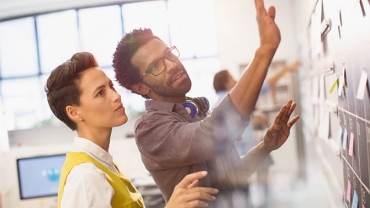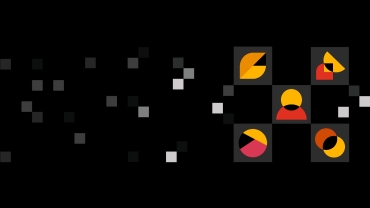
Episode 13: Designing a workplace experience that builds community, culture and leadership
Subscribe to our podcast
Who’s ready to banish the “two truths and a lie” ice-breaker? Now’s the perfect time. Today's employees want a more meaningful workplace experience — and the pandemic has provided invaluable lessons about how to create those connections.
Kristin Rivera and Suzanne Roske explore the importance of designing a workplace experience that builds community, culture and leadership.
Release date: August 2021
Full transcript
Kristin Rivera: Welcome to our podcast series, Emerge stronger through disruption. I'm Kristin Rivera, and I lead Global Forensics at PwC as well as our Global Crisis Centre. I’m coming to you today, once again, from my home office outside San Francisco, California.
In each episode of this series, we talk with global colleagues about the challenges facing business leaders during disruption. In our last couple of podcast episodes, we explored the return to the workplace and the personalisation of work. And in this episode, we'll continue in that vein with PwC partner Suzanne Fisher Roske for a discussion about a transformation project here at PwC that she led, and it changed the way that we engage with our clients and our people.
We'll also talk about how business leaders need to refocus on the experience of work. I think this is really timely as some parts of the world begin to transition away from working exclusively in a remote environment, and some countries see fewer restrictions. So, we're going to dig into this transition period, specifically, and talk about how we can create intentional experiences for workers in order to foster deeper connections.
But first, though, let me welcome Suzanne. Suzanne, could you share a bit about yourself?
Suzanne Fisher Roske: Absolutely, Kristin, thank you for having me. It's a pleasure to be here with you. As you said, I'm a partner in our Consulting Solutions practice and, starting about two years ago, prior to the pandemic, I started leading an initiative to introduce new ways of working into PwC that would create differentiated experiences for our clients and teams by combining business experience and technology. We spent time as a firm developing how to create these experiences in a way that's consistent and repeatable, but also allowed for flexibility and creativity.
And as we look at this time period, I think a lot of these elements will become really necessary as we think about transitioning back to more in-person working.
Kristin: I'm excited to have you join today to talk about that journey and how it translates into this new era. Returning to the office has the potential to be the dawn of a new day. How can we design a workplace experience that builds on that sense of community, culture and leadership we're all striving for?
So, what's fascinating, Suzanne, is that you were in the middle of designing this for PwC firm-wide before the pandemic hit. So, your intention was to create, at that time, more meaningful connections between people at work, whether they were in person or virtual.
I think we can all agree that in the past we clung to in-person hotel conferences or two-day meetings in the office, sort of assuming that if we just put people in a room together, these connections would magically be formed. And I think if we're really being honest with ourselves, that was a pretty expensive, time-consuming and inefficient — and often ineffective — way to deliver that desired result.
Suzanne: Yeah, I would agree with that. When we were planning to launch PwC’s new ways of working to our 55,000 people within the US, we realized that the ways that we had been working before were broken. Now, as we went through and we planned this launch, we had an original plan to have that grand hotel-style ballroom launch that you just mentioned. But as with everything, the pandemic threw a wrench into every single plan we had.
We knew at that point in time that we needed to do things differently. We needed to shake up our interactions. We needed to be more personal and make more meaningful connections across our teams and clients. But knowing something and then convincing people that there's a benefit to working differently — those are two completely different things.
And then when the pandemic set in and we realized this was not going to be that initial two-week quarantine that some of us naively thought of, we collectively experienced this seismic shift to working remotely — overnight. And immediately everyone needed to and accepted that we had to work differently in order to create these connections. We were really lucky to have these DIY tools that mirror the concepts and techniques that we've used and experienced successfully at some of these marquee events.
Today, as you mentioned, we're at another inflection point. And we have this really unique opportunity to take a breath and to critically look at the pre-pandemic state and the lessons of the pandemic, and then intentionally design how we're going to work together, moving forward.
Kristin: So, I think it's really interesting that even before the pandemic came about, you had identified and your team had identified the fact that sort of the way we were working historically wasn't optimal, that it was broken. And then the pandemic really created this golden opportunity — and even more so now, we don't have to go back to the way we were doing things before.
There is a huge opportunity to enhance that workplace experience. And honestly, I view this as just one more opportunity to emerge stronger from this pandemic. It's easier to just assume that what we were doing worked, but the reality is ... it wasn't optimal, and we cannot and should not go back.
Suzanne: Absolutely. Now, recognising that through the pandemic, there has been a lot of suffering and a lot of loss because of COVID. However, if we look carefully at how we worked remotely and how we had to adapt, there are some positives in that remote work experience that we should bring forward.
For example, video calls really level the playing field. In meetings, all the participants have the same size box on the computer screen. This helps flatten the hierarchy — and some of those big personalities in the room, if you were actually together, could have dominated the conversation. Everybody becomes the same size. The chat feature also really provides the opportunity for everyone to contribute. This is great for introverts — as one, I totally get it. Sometimes I can be a little quiet in meetings, but when I have the opportunity to just type my thoughts in, I and other people were able to contribute across meetings, and it really allowed people to be more free with their voice.
We often saw in meetings that people who were quiet actually started giving some of the best ideas that we would have — through ideation sessions and brainstorming as we went through and used these chat features. So, that's something that we really should seek to actively preserve as we move forward and back into a more face-to-face environment.
Kristin: I like that idea of pausing and taking a breath. Let's get tactical. So, take, for example, those old familiar icebreakers that we use to kick off meetings with — thinking that it would be a good way to start to foster those relationships and kick things off on the right foot.
How can we replace those with something that's more fresh, something that's more likely to genuinely build those connections we're looking for?
Suzanne: So, first of all, I would just like to make a plea that if we could please banish the “two truths and a lie” icebreaker, that would be fantastic. The next thing, getting to those tactical pieces, is as employees desire more meaningful relationships in their work — and we definitely see this, people want to get back together so that they can foster these relationships.
And one of the things we experienced during the past 18 months is that we got a slice into people's personal lives — whether it was the dog barking on a video call or kids showing up or plants. My daughter could hear people's voices and she would pop her head in and be like, “Hello,” just to say hi to certain people.
So, we got this sort of intimacy and humanity, and we need to continue that, because we are people that are bringing ourselves and we want that sense of belonging. And we don't have to lose that connection just because we're going back to the office. But if we want to keep it, we do need to be intentional about that.
Kristin: So, the challenge to business leaders today is: How do we let everybody know that we're not going to go back to that status quo? That the way that we interact in person must be enhanced in order to foster those relationships — and all of this coming at a time when, quite frankly, people are out of practice interacting in person. It might feel awkward. So, for those first few meetings, Suzanne, can you paint a picture for us of how things could look, maybe some examples of exercises to set the tone that might help illuminate this approach?
Suzanne: Sure. First of all, I think as leaders, there's a real benefit to naming things, to stating what might otherwise seem obvious and therefore might go unsaid. But giving people permission to experience a range of emotions that are coming with re-entry into the workplace. For me, acknowledging that this transition, as you said, could be awkward, and that people are at very different points in their re-entry journey, is key.
We all went out of the office at the exact same time. We're not all coming back at the same time — or even at the same place. And as leaders, we need to own that. And we need to allow our team members to actually express and feel comfortable being at their own point on the journey. We need to balance these statements with collaboration from the team as to how we want things to be.
So, the team really should create their working vision together. From a practical perspective, you can do this by conducting an exercise that captures people's hopes and fears. The questions are really easy — they can be asked to the team, and it can be something along the lines of what are your hopes and fears for returning to the office, working in a hybrid environment … whatever the situation is for your personal team or entity. This allows your team to each respond individually.
And it can be done with sticky notes or an online sharing application. It doesn't have to be fancy. You may hear things in responses like, “I hope we can have more in-person connectivity events to get reacquainted with the team.” Or something along the lines of “I'm fearful about losing the flexibility to exercise during the day.”
Just because we surface hopes and fears, it doesn't mean that we'll necessarily be able to act on or solve each. The goal is to surface, acknowledge and discuss the hopes and fears across the team.
Kristin: It really involves being honest and, dare I say, maybe even vulnerable. And although that can be really hard, particularly when we're out of practice, there's a ton of research that indicates that being more honest and vulnerable at work pays dividends and is a pathway to building those deeper relationships.
So, what's the next step, Suzanne? Where do you take the hopes and fears next?
Suzanne: That part about vulnerability that you mentioned, Kristin, is critical, because in order to surface what the real hopes and fears are, you do have to create that space of safety so that people can be vulnerable and can express what they're feeling. But from the hopes and fears, a way to move forward and not just have a bunch of things thrown up on sticky notes, is to get to team rules.
How does the team want to work together, moving forward, and really agree upon those? So, in that initial meeting or one of your first, you ask the team members to identify three things that they liked pre-pandemic or during the pandemic, and three things that they didn't like between and during the pandemic. And then you share those amongst the team, and the team can actually vote on the top three things that they want to continue and three things that they want to stop. Maybe the three things that they want to start, these become your team rules.
A good exercise to carry on to that and to really make the hopes and fears embedded into this, is to circle back and look at the proposed team rules and compare them to the hopes and fears. And if warranted, thinking about any rules to potentially address the hopes and fears that your team may have. This makes it actionable and allows everyone to then be accountable to how they want to move forward collectively.
Kristin: I like the way you're using that to tie this exercise meant to get people talking about, you know, again, hopes and fears, but then using that to tie into how you're going to work together as a team going forward. It almost is like it provides some guardrails for the team to ensure that these lessons and experiences aren't lost.
So, let's talk next about what happens if we don't take these steps. What would it mean if we just ignored this huge disruptive event and this whole new landscape? How could that avoidance of this new reality impact the team?
Suzanne: Yeah, this is something that I'm really worried about, Kristin, because if we think through some people's desire to get back at it, it's really easy to fall back into old habits. And as we started this, some of those things that we were doing pre-pandemic were broken and needed to be fixed. So, the risk of not proactively addressing how a team is going to operate as a hybrid team, for instance, and then holding people accountable to team rules — there's a risk that an in-office and an out-of-office way of operating can develop.
This can degrade diversity and equity, because people in the office may have the opportunity to have side conversations or the meeting behind the meeting. And immediately the people who are working remotely — they begin to feel left out. They're not as likely to contribute. They don't feel that sense of community. They don't feel as invested, and their sense of belonging and commitment falls off.
Kristin: So, as I was preparing for this conversation today, Suzanne, one of the things that occurred to me is that what you're proposing is pretty simple. Most business leaders can implement these ideas today, at no cost. So we're not talking about investing in technology or training your people.
These are simple tweaks you can make that can have a really meaningful impact. And you can even think of them as having cost-savings opportunities, because we're talking about using simple techniques to replace potentially costly in-person meetings.
Suzanne: Absolutely. At its core, this is really about asking thought-provoking questions and really listening to the answers. You need to let your people know that they're being heard and that actions are being taken to create an inclusive environment where the entire team can thrive. We want to create that psychological safety and trust across our teams. And for leaders, it's really exercising that EQ to ensure that we are going back to our teams and hearing how they want to work and what we will do to acknowledge and move forward with those ways of working.
Kristin: So, you've shared with us a number of terrific ways to get started, Suzanne. How do we keep this going in the long term? What can a business leader do to continue to drive this kind of value, and incorporate these techniques in order to drive more meaningful relationships and experiences at work?
Suzanne: So, let me give you three things.
First, nothing has to be a one-and-done. We're talking about this as we talk about some of these initial meetings, but we can and should revisit these team rules: what's working — look at it in a couple of days, a couple of weeks, a couple of months — and what's not. And then iterate, adjust what those team rules are, and move forward.
We are not going to get this right the first time. We didn't get it right the first time working remotely. We had some growing pains with it and it's going to be the same this way, but we want to encourage people to speak up so that we can make these adjustments.
Second, as leaders, we should continually revisit where team members’ strengths — or, if you will, superpowers — are, and where they want to grow. To create this space for this type of growth, you can ask team members: What are your unique skills that you bring to this project? And how could these skills be better utilized? This really allows people to think about where they want to go, but also if they have any sort of opportunity to contribute more, that someone may not recognize right off the bat.
And third, it's really important to understand when and how the team will come together, and how we can make these interactions memorable.
Let's commit to not going back to stadium seating in a board or a ballroom. Up front, teams can agree to milestones, both big and small. You want to be genuine as you connect and celebrate — and do the unexpected.
Do you have to have a happy hour? How about a story hour, where you share 10 magic moments that have occurred during a part of a project? Or share what you're grateful for by honoring team members. You can be brave, be vulnerable, and maybe be a little silly. Create a memory for a shared experience, whether it's a superlative again, Kristin, as you said, this doesn't have to be big, fancy or expensive — but it does have to be meaningful.
I recently heard about a colleague that was given a role of lifesaver candy and a little post-it note on it that said, “Thanks for your words of encouragement. You were a true lifesaver.”
Kristin: Suzanne, that's a great way to end. Thanks for joining me today. It was a really great conversation.
Suzanne: Thank you, Kristin. It was terrific to be with you.
Kristin: In our next episode, we'll speak with our cyber colleagues about how business leaders can become more resilient and face the threat landscape that's evolved during the pandemic.
Remember to subscribe to our podcast series, Emerge stronger through disruption, wherever you get your podcasts. Also, don't forget to connect with Suzanne and me on LinkedIn. Until next time, thanks for listening.

















